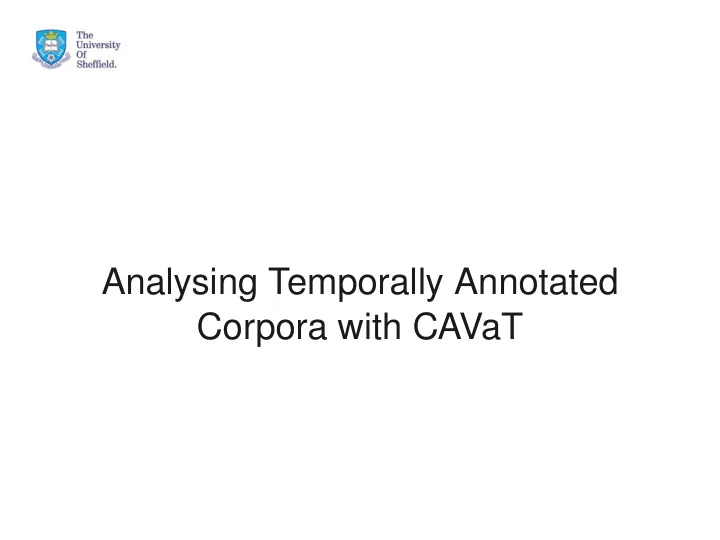

Analysing Temporally Annotated Corpora with CAVaT
Temporal Annotation What to annotate? ● Events and time expressions (intervals) ● Temporal, aspectual and subordinate links between intervals ● Signals that indicate recurrence or temporal ordering TimeML is a formal specification for annotating these kinds of entity
Surveying temporally annotated corpora To learn about how time is expressed in English, we can examine a temporally annotated corpus – TimeBank At a high level, we can gather TimeML tag and attribute frequency distributions Basic tools to do this quickly - sed/awk/grep These quickly become awkward and prone to human error
Surveying temporally annotated corpora To see the distribution of PoS type in a TimeML corpus: $ grep -h MAKEI ~/corpora/timebank_1_2/data/timeml/* | sed 's/>/>\n/g' | grep MAKEI | sed 's/ /\n/g' | grep pos= | sed 's/\/>//' | sort | uniq -c 266 pos="ADJECTIVE" 2225 pos="NOUN" 299 pos="OTHER" 28 pos="PREPOSITION" 5122 pos="VERB"
Surveying temporally annotated corpora Solution: Parse TimeML corpus and load it into a database Query the database with SQL ● Much easier than complex command lines! Often we want specially-formatted output (LaTeX tables) There is a core set of queries that are very similar and are used very frequently
The CAVaT prompt cavat> Readline-based interface Flexible PyParsing grammar Query specification is kept close to natural-language Online help available for most commands Multiple output formats: ● LaTeX ● CSV ● screen
The CAVaT prompt To see the distribution of PoS type in a TimeML corpus: # CAVaT Corpus Analysis and Validation for TimeML # Version: 0.2 Support: leon@dcs.shef.ac.uk cavat> show distribution of event pos Frequency EVENT pos Proportion =============================================== 5122 VERB 64.5% 2225 NOUN 28.0% 299 OTHER 3.77% 266 ADJECTIVE 3.35% 28 PREPOSITION 0.353% 7940 Total If we're writing a report, we can just enter: cavat> show distribution of event pos as latex
Problems in existing TimeML corpora In earlier research, we found some issues with TimeBank: ● Building a TLINK relType classifier, we found events that were ordered as being after themselves (odd). ● TLINKs introduced via temporal closure sometimes conflicted with initial annotations To help TimeML annotators spot these errors in future, CAVaT includes validation checks. CAVaT checks are modular and can be authored with only knowledge of the database schema.
Looped TLINK check When both arguments of a TLINK reference the same event instance. From wsj_0586.tml: <TLINK lid="l192" relType="BEFORE" eventInstanceID="ei1404" relatedToEventInstance="ei1404"/> For simultaneous or identity relations, the link is redundant; If the relation type is anything else, it is erroneous. Give a warning if a TLINK links two different instances of the same event
Looped TLINK check Example output: cavat> check tlink_loop in all # TLINK loop checker v1 loaded # Checking wsj_0736.tml (id 4) TLINK ID l48 loops directly (instanceID match), type IDENTITY, event ei316 / ei316 # Checking APW19980227.0494.tml (id 38) TLINK ID l61 loops directly (instanceID match), type AFTER, event ei2338 / ei2338 # Checking ABC19980304.1830.1636.tml (id 165) TLINK ID l23 may be a loop (eventID match), type INCLUDES, event ei286 / ei288 - check document manually
Consistency check The temporal links, events and timexes in a document can be though of edges and nodes in a temporal graph. Not all temporal graphs are consistent; for example, ● A before B ● B before C ● C before A CAVaT includes an agenda-based temporal consistency check, which first converts intervals to pairs of points, and then attempts to perform a closure. Conflicting information indicates an inconsistency.
Consistency check cavat> check consistent in all # Temporal graph consistency checker v1 loaded # Checking wsj_0927.tml (id 3) ! Inconsistent closure - could not assert (ei2415_2 < ei2414_1) # Checking wsj_0778.tml (id 7) ! Inconsistent closure - could not assert (ei2090_2 < ei1988_2) # Checking wsj_0762.tml (id 10) ! Inconsistent closure - could not assert (ei2005_2 < ei2003_2) ...
Advanced uses Orphan detection finds elements not linked to the rest of the document. ● Helps avoid incomplete annotation ● Events or timexes not linked at all ● Uninstantiated events ● Instances of non-existent events ● Signals not referenced by a TLINK or event instance
Advanced uses Subgraph identification : ● A document may have multiple independent temporal subgraphs ● Identify subgraph sizes and count ● Report on how well a document is linked overall with an entropy-based measure
Advanced uses cavat> check split_graph in wsj_0132.tml # Split graph detection v1 loaded # Checking wsj_0132.tml (id 1) Subgraphs found: 3 - composed of 28 nodes and linked by 25 TLINKS. Isolated subgraphs, that contain just one TLINK: 2 (making up 66.7% of all subgraphs / consuming 14.3% of all nodes / described by 8.0% of all TLINKs); Mean graph size 9.3 nodes; largest subgraph (size 24) has 85.7% of all nodes. Entropy of subgraph sizes: 0.15279294609 2 nodes: ( 2) .. 24 nodes: ( 1) . TLINK loops manifest as single-node subgraphs
Future work Extensions to query syntax ● “save” keyword to dump results to a file ● “signalled” keyword for elements that link to a signal Extra checks ● S2T verification ● Ensure SLINKs only interact with certain event classes Feature generation for classifier training
Open project Available via SVN at: http://code.google.com/p/cavat/ Extensible check module architecture; an example class is included Thank you! Any questions?
Recommend
More recommend